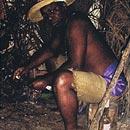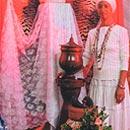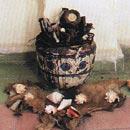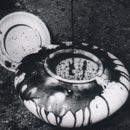The Caribbean,A blend of cultures and religions
Numerous researchers have looked into the Caribbean from its historical, political, social and cultural features. Today, its definition remains pretty much in the dark. There are some who prefer geographical or historical grouping patterns, while others turn to cultural ones. Either case, though, there's no doubt about the region's ingrained unity regardless of an outstanding ethnic, linguistic and religious plurality.
The Caribbean Basin was the setting of the discovery or encounter of two worlds that had until then been wide apart. The region served as a stepping stone for a conquest that soon spread to the mainland. It was the meeting ground for the European powers of yesteryear led by Spain and its rivals –France, England and Holland- which eventually played a hegemonic role in the development of these peoples, determining their traditions, languages and religions, as well as their social relations and structures.
The European colonization soon begot the problem of workforce. The autochthonous population –virtually killed off on the insular regions- was replaced as early as the 16th century. This gave birth to slavery, one of the most scornful trades history has even known and whose main goal consisted of massive slave deportation from different regions of sub-Saharan Africa, especially from the western side of the black continent, in order to clinch the necessary workforce.
Since 1501, as many as 15 million Africans from different ethnic groups were brought to the West Indies. Yorubas, Lucumis, Bantus, Mandingas, Araras, Minas, Fantis, Fons, Mayombes and countless others set foot on the Caribbean. Each and every one of them brought along their traditions, customs, dialects and religions that were transformed within the new framework those men had to cope with, totally stripped of their own material culture.
Slaves not only lost their free lives and labors, but also their collective memory and social setting whereby peoples recreate and hand down, from one generation to the next, their experiences and particular ways of being.
They reacted in different ways. One prevailing reaction that for the most part led to the survival of their own culture was boosted by those who defeated overwork's physical and moral sorrow at any rate –and the new kind of culture conquistadors try to ram down their throats. Those Negroes found shelter up in the mountains and into the jungles only to set up communities of runaway slaves in an effort to preserve their freedom and identity as much as possible. From their secret hideouts, they worked the land and produced foodstuffs self-sufficiently to make ends meet in those harrowing living conditions.
The behavior of runaway slaves or cimarrones, penciled in as a phenomenon of cultural resistance, exerted a strong influence in the religiousness of enslaved men, who never gave in their own beliefs to other religious practices, not even to those imposed by colonizers. Thus, the Caribbean became dwelt by Orishas, Loas, Ngangas and Drums, leading the path to the appearance of syncretism –a process that had already occurred centuries ago in Africa due to the contact with Islamism.
Creativeness and firmness were syncretism's two dominant features. Patterns of millenary cultures were absorbed, in most cases ruling out the dominant-dominated condition.
In addition to this, slaves used to be subjected to religious indoctrination in keeping with their masters' needs of providing them with a language –that of the conquistadors- and a religion –Catholicism- good enough to bring slaves from different ethnic groups together.
In 1685 and under the rule of the Code Noir –stating that after a brief period of time slaves were to be indoctrinated and baptized in the Catholic faith- Africans were banned to take part in their own religious ceremonies. This prompted them to keep their rites under wraps and religion turned out to be an arcane cult. Believers were labeled as conspirators and sacred meetings were soon taken down as rebellion cells.
However, plantation owners didn't know that slaves' parties, music and dancing were only traditional ways of invoking their ancestral deities and celebrating liturgy. Against all odds, slaves held on to their religious beliefs.
Nonstop slave rebellions were no doubt signals of their willingness to break free, firstly, from the economic exploitation they were submitted to, and secondly, from the colonizer's cultural domination that excluded the oppressed people's beliefs every step of the way.
In every process of cultural oppression, submitted communities develop defensive tactics in a piecemeal fashion with a view to make their own cultural values prevail over the oppressor's. Despite the loss of many traditional values, several African-origin cultural manifestations outlived centuries of exploitation and were orally passed on to from generation to generation. Music, dancing, linguistic remnants, cooking traditions and religion make up the Caribbean identity.
Especially as far as religion is concerned –construed as a unified system of beliefs and sacred ceremonies- analogies among aboriginal, Hispanic and African religious elements led to a constant exchange that eventually paved the way for a new kind of religiousness that has varied depending on their practitioners' status and context in each and every span of time.
These similarities boosted the loss of some features, the acquisition of others and the appearance of new elements, despite tha that unlike other fields, man is extremely conservative when it comes to religion.
On the other hand, the European gospel-pushing process could not do away with African-origin animist practices and heathen beliefs, elements that contributed in a way to ingrain certain religious concepts.
Popular religions in the Caribbean –to tell them apart from ecclesiastic ones –are marked by their association to daily life and people's cultures and problems. Syncretism of Catholic elements and Indo-American or African cults is commonplace: festive elements, myths and superstition, pilgrimages and icons, ex-votes and pledges, plus a distinctive utilitarian character.
The African-origin religious systems that bludgeoned in the Caribbean are good cases in point. Haitians, for instance, observe voodoo, a religious rite that reached Caribbean shores back in the 18th century. Its history is closely spliced into the country's longstanding process of national ethnic formation and harks back to the times when the first slaves arrived in the French-ruled west side of La Hispaniola.
In Venezuela, on the other hand, people there worship Maria Lionza, a cult in which the nation's three existing ethnic groups come symbolically together: the icons of Maria Lionza (Hispanic), the Guaicaipuro Indian (aboriginal) and Pedro Camejo, the First Negro (African).
Cuba's Regla Osha, Regla Conga or Palo Monte, as well as Abakua, are religious systems based on concepts brought along by slaves who made it to the island nation during the colonial rule. Today, those rituals –they vary in each and every case- are practiced by a good deal of the population and remain deeply rooted in the very core of society.
For its part, the Cult of Chango grew roots of its own in Trinidad & Tobago as slaves hailing from ancient Yoruba communities and other Caribbean islands brought elements of those rites with them. The rituals developed all through the 19th century and melted into Catholicism. Chango is the generic moniker used to denominate the cult of the Yoruba Orishas which is observed quite similarly in Grenada.
The Shouters –equally practiced on the aforesaid island nations- relate to a sect dating back to the Shakers Movement (a brotherhood of believers founded in England in the late 18th century) and to the Baptist religion brought to Trinidad and Tobago by American missionaries. The Shakers was the sect's original name, but its members now despise that term. That's why they are also known as the Spiritual Baptists.
In the same breath, Rastafarians play a significant social and political role in Jamaica –their place of origin- and on other Caribbean islands. The movement's underpinnings lie in the philosophy of Jamaican-born Marcus Garvey (1914-1940) who stressed black superiority in society. Rastafarians incorporate an array of African religions and narrations excerpted from the Old Testament.
Each and every one of these cults, that often paint the Caribbean with that motley shade many are inclined to linking the region with, stands for a fusion of dynamic elements inserted in a new context in line with the location's demands. Even though there's a certain liturgical homogeneity, in many cases ritual diversity is pretty abundant.
Back in 1940, Cuban anthropologist Don Fernando Ortiz laid bare the essential feature of the entire Caribbean by coining the term transculturalization to express that gaudy diversity that pops up when different people convene in the same space.
No wonder that from the moment these great civilizations clashed with each other, a nonstop process of value loss and assimilation began. The result was the emergence of a new, complex and diverse reality that brought on the formation of a one-and-only, dynamic and half-breed kind of Caribbean culture.








































































